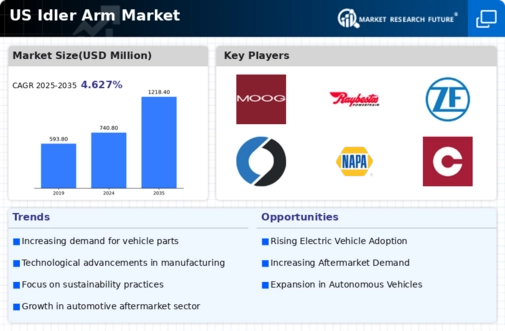The US Idler Arm Market is characterized by a competitive landscape marked by various players that offer a wide range of idler arms aimed at enhancing vehicle performance and durability. This market has seen significant growth due to increasing vehicle production, coupled with rising consumer awareness regarding vehicle maintenance and the importance of high-quality auto parts. The idler arm serves a vital role in steering components, and as a result, the demand for durable and reliable idler arms continues to expand. Companies in this market focus on product innovation, strategic partnerships, and supply chain efficiency to gain a competitive edge.
Market participants engage in extensive research and development to introduce advanced materials and designs that improve the longevity and performance of idler arms. This competitive environment drives manufacturers to differentiate their offerings through superior quality, pricing strategies, and exceptional customer service.Moog has established a prominent presence in the US Idler Arm Market, known for its robust reputation for quality and reliability.
The company's strength lies in its extensive product line that caters to a diverse array of vehicles, ensuring that customers have access to idler arms that meet their specific needs. Moog's commitment to innovation allows it to remain at the forefront of the market, offering advanced designs that improve vehicle handling and safety. Furthermore, Moog benefits from a well-established distribution network, ensuring that its products are readily available to both consumers and auto repair shops across the United States.
The strong brand recognition and trust that Moog has cultivated over the years enhance its competitive position, enabling it to effectively withstand market fluctuations and meet evolving consumer demands with efficiency.
Raybestos is another notable player within the US Idler Arm Market, recognized for its comprehensive range of automotive products that include high-quality idler arms. The company focuses on providing reliable replacement parts that cater to both aftermarket and original equipment markets. Raybestos has bolstered its market presence through strategic mergers and acquisitions, further expanding its product portfolio and enhancing its distribution capabilities. In addition to idler arms, the company also produces a variety of other auto parts, helping to position itself as a one-stop-shop for automotive needs.
Raybestos's strengths lie in its commitment to quality, innovation, and customer service, which resonates with consumers looking for premium automotive parts. The company invests significantly in research and development to ensure that its products conform to rigorous industry standards, thereby reinforcing its reputation for reliability and performance in the competitive landscape of the US idler arm market.






















Leave a Comment